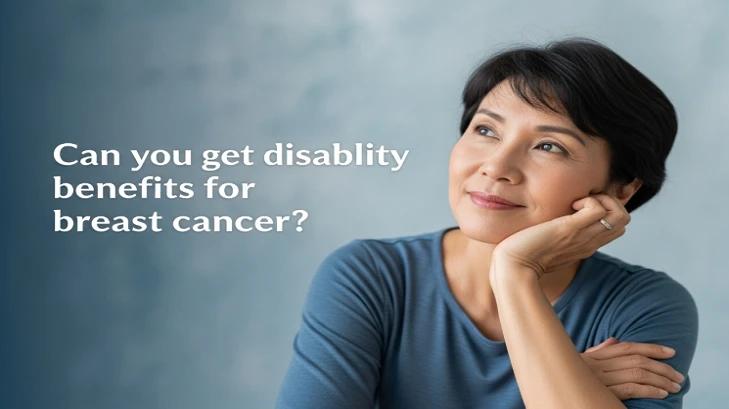- Author: Richard Stim
- Jul 14, 2025
Are you unable to work due to breast cancer? If so, you may be eligible for monthly disability benefits along with additional health insurance from the United States government.
Numerous patients, alongside their families affected by breast cancer, get benefits from the Social Security Administration. However, not all individuals are eligible, and navigating government policies may seem complicated.
Can you get disability benefits for breast cancer?
Yes, you can qualify for breast cancer disability benefits if it and its treatment significantly impair your ability to work and meet the Social Security Administration’s (SSA) disability criteria mentioned in the Blue Book.
If your breast cancer is aggressive, late-stage, or requires long-term treatment, you may be eligible for Social Security Disability Benefits.
According to the Americans with Disabilities Act (ADA), applicants will be protected from discrimination. As breast cancer is one of the types of cancer listed in the SSA’s Blue Book in Section 13.10, individuals struggling with the disability may be eligible for cancer disability benefits.
What Is Breast Cancer?
Breast cancer is one of the types of cancer that originates in the breast cells. It happens when abnormal cells in the breast grow and multiply uncontrollably, forming a mass or lump called a tumor. Breast cancer can affect both women and men, although it is much more common in women.

Symptoms Of Breast Cancer
Cancer symptoms can vary widely depending on the type, location, and cancer stage. However, some common signs and symptoms that may indicate the presence of cancer include
- Weight loss
- Persistent fatigue
- Unrelenting pain
- Changes in the skin
- Persistent cough
- Difficulty swallowing
- Blood in the urine or stool
- Chronic pain or stomach pain
- Frequent infections or illnesses
- Anxiety
- Depression
Common Causes Of Breast Cancer
The exact causes of breast cancer are not fully understood, but several factors may increase the risk:
- Genetics
- Age and Gender
- Family History
- Hormones
- Personal History
- Radiation Exposure
- Lifestyle Factors
Does Breast Cancer Automatically Qualify For Disability Benefits?
Some types of breast cancer can automatically qualify for benefits that are severe, long-lasting, and prevent you from holding a job. Under the Compassionate Allowances Program, some medical conditions that require a kidney transplant, or in which the applicant loses both legs, may qualify for Social Security disability benefits.
Getting approved for the benefits depends entirely on how your illness progresses and how it impacts your ability to work.
Is Breast Cancer A Disability?
Breast cancer is not automatically considered a disability under the Social Security Administration’s (SSA) definition. However, individuals with breast cancer may be eligible for disability benefits if the cancer and its treatment significantly impair their ability to work and meet the SSA’s disability criteria.
Eligibility Criteria for breast cancer
To qualify for disability benefits from the SSA, including Social Security Disability Insurance (SSDI) or Supplemental Security Income (SSI), an individual must meet the following criteria:
-
Listing of Impairments: If the breast cancer and its complications meet specific medical criteria listed in the SSA’s “Blue Book” (Listing of Impairments), the individual may be considered disabled automatically.
-
Inability to Work: If breast cancer and its treatment significantly impact the individual’s ability to work and earn a living, they may be eligible for disability benefits even if the condition does not meet a specific listing in the Blue Book.
-
Duration: The disability must be expected to last for at least 12 months or more.
The SSA evaluates each disability claim on a case-by-case basis, considering the medical evidence, functional limitations, and the overall impact of the condition on the individual’s ability to work.
When Does Breast Cancer Qualify For Disability Benefits?
Breast cancer may qualify an applicant for benefits if any one of the following is true:
-
You are suffering from stage IV (stage 4) breast cancer, which is metastatic. It means that your cancer has spread to other parts of the body.
-
Breast cancer that cannot be cured or is inoperable will automatically qualify for disability benefits.
-
You are struggling with inflammatory breast cancer (IBC), which will automatically qualify you for benefits.
-
Breast cancer has reached small cells, also known as oat cells, which will qualify you for benefits.
-
Your medical treatment is expected to last for 12 months or more. Moreover, during that tenure, you are experiencing side effects, thereby making it impossible for you to work.
What Benefits Can I Qualify For Breast Cancer?
There are fundamentally two types of benefits provided by the Social Security Administration (SSA)
- Social Security Disability Insurance (SSDI)
- Supplemental Security Income (SSI)
Social Security Disability Insurance (SSDI)
SSDI is a program provided by the SSA to Americans who are medically disabled and are unable to hold a job. If someone says they are on disability, it means that they are getting payments from the SSA. In the year 2022, 7.6 million disabled workers were approved for Social Security Disability Insurance (SSDI). Applicants who qualify for the benefits will get the following advantages:
- They will receive a monthly check of $3,822 in 2024
- Will receive free health insurance through Medicaid or Medicare
- Extra money for young kids
- Forgiveness of student loan debt
- Higher social security retirement payments later in life
- You can apply for the program for free
To qualify for SSDI, you need to be honest in providing six main things:
- Applicant must be under 66 years old
- Taking treatment for a severe medical condition
- Owing to your medical condition, you will be unable to hold a job
- You are not working presently, either part-time or low-paid
- Unable to recover within 12 months
- Before struggling with your disorder, you worked and paid your taxes
Supplemental Security Income
If you and your family have little income and resources and have never worked, you can still get benefits by applying for Supplemental Security Income (SSI). With this program, you will be able to get $943 every month in 2024. In some cases, applicants may qualify for both SSDI and SSI. However, it will entirely depend on your medical condition and the seriousness of your disability.
Can I Apply For Benefits If I Have Breast Cancer?
If you are unable to work due to your breast cancer and your healthcare providers are saying that you cannot get better within 12 months, you can apply for the benefits. However, applying for the benefits may take time and is a complex procedure.
-
An applicant must apply now if they are unable to work due to their cancer symptoms and side effects after treatment. You are suffering from Stage-4 or small cell breast cancer, and you cannot recover within one year.
-
An applicant must wait if their cancer is just diagnosed and it is mild or moderate and can be cured with medical treatment.
-
You must not apply if your breast cancer is not hampering your job or work, and you will recover within one year as per your doctor. You must not apply if you are earning more than $1,550 every month.
How The Application Procedure For Breast Cancer Works?
-
Initial Application: You complete an elaborate application form where you outline your work history, provide all relevant treatment records, and submit your medical documents. A government employee reviews your paperwork and decides.
-
Appeals: You contest the denial and eventually receive a decision from a judge after several steps. In this stage, you have the opportunity to present further documents and cross-examine the government witnesses.
How Can An Attorney Help Me When My Disability Benefits Get Denied?
When your benefits get denied, a disability lawyer can be a valuable ally in helping you navigate the complex appeals process. They will thoroughly review your case, identify any weaknesses in your initial application, and gather additional medical evidence.
FAQs about Breast Cancer?
Can I Qualify for Disability Benefits if I have Breast Cancer?
If your cancer or its treatment significantly limits your ability to work and meets the Social Security Administration’s Blue Book criteria (especially Section 13.10), you may be eligible for disability benefits.
What Stages of Breast Cancer may Qualify Automatically for Benefits?
Advanced, metastatic (Stage IV), inoperable, or inflammatory breast cancers — or those expected to last 12 months or more — often meet SSA’s criteria for expedited approval.
How does the Compassionate Allowances Program apply to Breast Cancer?
While not all cancers qualify, aggressive and late-stage breast cancer types may be fast-tracked under this program. Eligibility depends on severity and prognosis.
Why is Documentation Important for Breast Cancer Disability Claims?
Thorough medical records showing diagnosis, treatments, and functional limitations are essential to support your claim and help SSA assess eligibility accurately.


